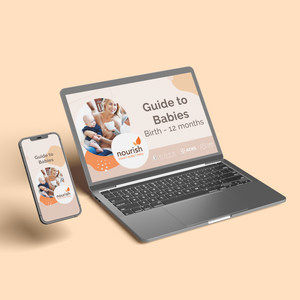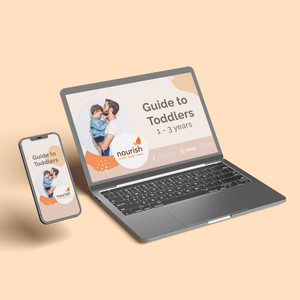Key Points
- Twins and multiples are becoming more common due to fertility treatments and ovulation-inducing medications
- Age, race, fertility treatments, and family history all contribute to the likelihood of conceiving twins or multiples
- Carrying multiples increases the risk of complications during pregnancy, such as gestational diabetes, premature labor, and low birth weight, necessitating careful monitoring and dietary considerations
One of the many questions expectant parents ask at the first ultrasound is “is it only one baby”? That’s because the possibility of having twins or multiples exists for all of us. Some families however, are more likely than others to have more than one baby at a time.
Twins and multiples are more common since fertility drugs and assisted reproduction technology have become such an accepted part of our culture. To optimise the chances of at least one successful pregnancy, (generally) more than one embryo is transferred. And boosting ovulation with fertility drugs often leads to more than one egg being released.
Twins - the Basics
There are two types of twins: fraternal (dizygotic) and identical (monozygotic). Twins do tend to run in families where there can be a pattern of women carrying multiples. It’s not only mothers who pass on the ability to hyper ovulate to their daughters, fathers can carry this gene and pass it onto their girls. Men produce millions of sperm whereas the number of eggs a woman releases each month varies.
Fraternal twins are just like any other siblings but they just happen to have been fertilised at the same time. Two eggs are fertilised by two separate sperm and then implant in the uterus. Fraternal twins share approximately 50% of the same genetic material and may look like each other and be a boy/boy; girl/girl or boy/girl combinations.
Fraternal twins each have their own placenta and are in separate amniotic sacs. Genetics plays more of a role in them being conceived than for identical twins.
Identical or monozygotic twins occur when one egg is fertilised by one sperm and then splits into two identical parts. This means the babies share the same DNA and are always the same sex. Identical twins generally share the same placenta and are in the same amniotic sac.
Conceiving identical twins is not influenced by genetics and research has shown that identical twinning is a random occurrence.
Just how Common are Twins and Multiples?
According to the Australian Bureau of Statistics latest data from February 2017, in 2015 twins accounted for 1.4% of all births and triplets and higher order multiples represented 0.03% of all births.
The proportion of births which have resulted in a multiples birth has been fairly consistent for the last ten years.
What we Know to be True
Research has shown that older women aged between 35-40 years are three times more likely to give birth to fraternal (non-identical) twins than women aged 20-25. Some experts believe this is nature’s way of maximising the chances of a woman’s DNA continuing by conceiving more offspring before she reaches menopause. Kind of a last gasp before it’s too late.
Race, fertility assistance and a past history of having twins also increase the likelihood of conceiving multiples.
The birth rates for monozygotic (identical) twins are the same throughout all races – around 4 in 1000 births. But the incidence of dizygotic (non-identical) twins varies between races with around 8 per 1000 within the Caucasian population and around 16 per 1000 births among people of African descent. Around 4 per 1000 people from Asian background have twins.
Triplets and More
Triplets and quadruplets can be formed from a combination of factors. They can be trizygotic (three) or quadrizygotic (four) zygotes which share identical or separate DNA. Triplets and more can form through a combination of identical and fraternal multiples, so two (or more) of the babies may be twins and the third (and fourth) baby a fraternal triplet.
Your Health
Being pregnant with twins or multiples means the mother needs to be very carefully monitored. Although pregnancy is a normal, healthy state, the added stress of carrying an extra baby/babies does put additional strain on her body.
There are also extra risks associated with a multiple pregnancy, such as:
- Miscarriage
- Gestational Diabetes
- Premature labour and birth
- Intrauterine growth restriction (IUGR) and/or low birth weight
- Preeclampsia
- Placental abruption
- Foetal death
- Caesarian birth or a more complicated delivery
But I’m Starving!
It can be very helpful for women who are carrying multiples to speak with a dietician to ensure they are getting sufficient nutrients. Whilst our Pregnancy Eating Guide has a plethora of useful information, it may be best to consult with a Dieticians who specialise in pregnancy support. They are often based in large metropolitan maternity hospitals. Check here to help find a dietician who is close to you.
The most important recommendation around diet and healthy eating during pregnancy is to forget the old adage of “eating for two”. What’s important is to concentrate on the nutritional content and value of foods you eat. You will need extra protein, calcium, iron, iodine, folic acid, vitamin D and vitamin B12 than if you were carrying one baby.
Five Top Tips for a Healthy Twin/Multiple Pregnancy
- Get enough rest. Your body is working hard to support your babies’ growth. Lie down when you can and if you can’t sleep, aim to just rest and get your feet elevated.
- Drink plenty of fluids – at least eight large glasses of water each day.
- Look for snacks which are “slow-burning” and take longer for your body to digest. Whole grain breads and cereals, nuts, fruit and dairy foods will help to fuel your energy.
- During your pregnancy, organise a list of trusted support people who’ll give you practical help once your babies are born.
- Be realistic about what you can achieve in each day. 24 hours a day your body is supporting your babies, be kind to yourself.
Where to get more Information
- Your GP and maternity care provider.
- The Multiple Birth Association in your State or Territory
References
- https://www.amba.org.au/
- https://www.twins.org.au/twins-and-families/about-twins
- https://www.betterhealth.vic.gov.au/health/servicesandsupport/twins-and-multiple-births
This article was written for Nourish by Jane Barry, midwife and child health nurse.
Our Products
-

01. Guide to a Healthy Pregnancy
$55 -

02. Positive Birthing Course
$55 -

03. Infant Feeding Guide
$55 -

04. Baby Sleep Guide - First 12 Months
$55 -

05. Toddler Parenting Course 1 - 3 Years
$55
-
 When to Start Antenatal Classes?
When to Start Antenatal Classes?
Becoming a parent is an incredible milestone, but it comes with a host of changes that can be daunting, especially for first time parents. Antenatal classes are all about offering expectant parents the education they need to make informed decisions, look after their bodies and care for their newborn babies. While you probably already have a long list of things you need to accomplish during your pregnancy, it’s a good idea to make time to attend antenatal classes.
-
 Development Milestones 4-8 Months
Development Milestones 4-8 Months
As they reach the middle of their first year, you'll start to see bigger leaps in their growth and ability!
In this article, we’re going to discuss your baby’s developmental milestones between 4-8 months, and what you can expect along the way.





 When to Start Antenatal Classes?
When to Start Antenatal Classes?
 Development Milestones 4-8 Months
Development Milestones 4-8 Months








